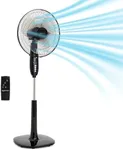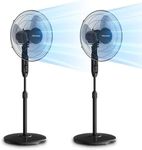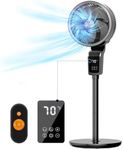Buying Guide for the Best Pedestal Stand Fans
When choosing a pedestal stand fan, it's important to consider several key specifications to ensure you get the best fit for your needs. Pedestal fans are versatile and can be used in various settings, from bedrooms to living rooms, and even offices. They provide a cost-effective way to cool down a room and improve air circulation. To make an informed decision, you should understand the different features and how they impact the fan's performance and usability.Fan SizeFan size refers to the diameter of the fan blades, typically measured in inches. This spec is important because it affects the amount of air the fan can move. Smaller fans (10-12 inches) are suitable for personal use or small rooms, while medium-sized fans (14-16 inches) are good for average-sized rooms. Larger fans (18 inches and above) are ideal for larger spaces or areas that require more powerful airflow. Choose a fan size based on the room size and the level of cooling you need.
Speed SettingsSpeed settings determine how fast the fan blades rotate, which in turn affects the airflow and cooling effect. Most pedestal fans come with multiple speed settings, usually ranging from 3 to 5. This spec is important because it allows you to adjust the fan's performance to your comfort level. For instance, a low setting might be sufficient for a gentle breeze, while a high setting can provide more intense cooling. Consider how much control you want over the airflow when choosing a fan with the appropriate number of speed settings.
OscillationOscillation refers to the fan's ability to rotate from side to side, distributing air more evenly throughout the room. This feature is important for ensuring that the entire room gets cooled rather than just one spot. Fans with oscillation can cover a wider area, making them more effective in larger spaces. If you need to cool a larger room or want more even air distribution, look for a fan with an oscillation feature.
Height AdjustabilityHeight adjustability allows you to change the height of the fan to better suit your needs. This spec is important for directing airflow exactly where you need it, whether you're sitting, standing, or lying down. Fans with adjustable height can be more versatile and convenient, especially if you plan to use the fan in different settings or for different purposes. Consider how you will use the fan and whether adjustable height is a feature that will enhance its usability for you.
Noise LevelNoise level refers to how loud the fan is when operating, usually measured in decibels (dB). This spec is important because a noisy fan can be disruptive, especially in quiet environments like bedrooms or offices. Fans with lower noise levels (below 50 dB) are generally quieter and more suitable for such settings. If you are sensitive to noise or plan to use the fan in a quiet space, look for models that are specifically designed to operate quietly.
Remote ControlA remote control allows you to operate the fan from a distance, providing added convenience. This spec is important for ease of use, especially if you want to adjust the fan settings without getting up. Fans with remote controls can be particularly useful in larger rooms or for individuals with limited mobility. If convenience and ease of use are priorities for you, consider choosing a fan that comes with a remote control.
Timer FunctionA timer function allows you to set the fan to turn off automatically after a certain period. This spec is important for energy efficiency and convenience, as it ensures the fan doesn't run longer than needed. Fans with timer functions can help save energy and are useful if you want the fan to turn off after you fall asleep or leave the room. If you are looking for ways to manage energy consumption and enhance convenience, a fan with a timer function might be a good choice.






















